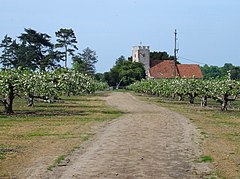Norton, Buckland and Stone
| Norton, Buckland and Stone | |
|---|---|
 The Kentish Church of St Mary in the orchard |
|
 Cherry orchard at Norton |
|
| Norton, Buckland and Stone shown within Kent | |
| Population | 337 2001 Census 467 (2011) |
| OS grid reference | TQ 96759 6 |
| District | |
| Shire county | |
| Region | |
| Country | England |
| Sovereign state | United Kingdom |
| Post town | Sittingbourne |
| Postcode district | ME9 |
| Dialling code | 01227 |
| Police | Kent |
| Fire | Kent |
| Ambulance | South East Coast |
| EU Parliament | South East England |
| UK Parliament | |
Norton, Buckland and Stone is a small rural civil parish 1 mile (1.6 km) east of Teynham and 3 miles (4.8 km) west of the centre of Faversham in the borough of Swale, Kent, England. It is bypassed by the M2 to the south and traverses the historic A2, on the route of the Roman road of Watling Street.
In 1798, Edward Hasted records that Norton, was written in ancient records as 'Northtune'.
The manor was previously owned by Odo, Earl of Kent (as the Bishop of Bayeux), at the time of the Domesday Survey. It was recorded as 'Nortone'. The parish had three churches, and three mills without tallage (land tax),and two fisheries of twelve pence. Wood for the pannage (grazing) of forty hogs.
But after his trial (for fraud) in 1076. His assets were re-apportioned including Badlesmere. The parish returned to the crown who passed it to 'Hugo de Port'. Then it passed to John de Campania (of Newenham), with a rent of 30 shillings going to Rochester Castle. In 1790, it passed to John Bennett, esquire of Faversham.
This central area constitutes the main settlement with the parish church. The two most populated roads of the parish are Lewson Street Road, forming with one side road a distinct, largely thatched roof hamlet with the relatively large public house, 'The Plough', and the oldest listed cottage World's End, both 16th century, and the mainly agricultural nearby Norton Road. On the latter are Norton Court, listed grade II*, dating to the 17th century remodelled by architect Sir Reginald Blomfield and Norton Court Lodge, grade II. The church lies along a straight east-west footpath from the Court leading to a large house named Provender, listed grade II* and dating to the 16th century.
...
Wikipedia

